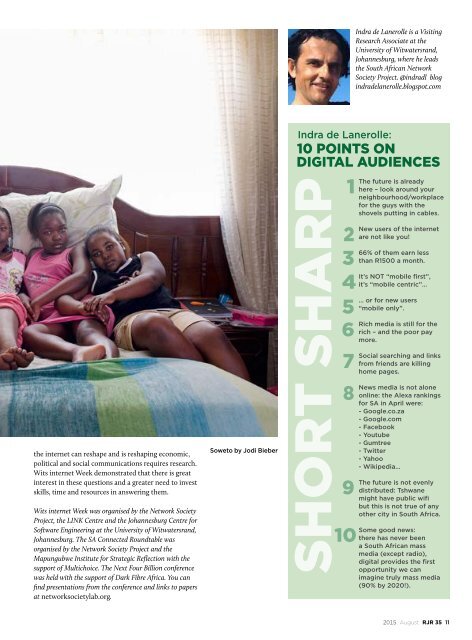Full RJR35
Create successful ePaper yourself
Turn your PDF publications into a flip-book with our unique Google optimized e-Paper software.
Andrew Phelps, the Senior Product Manager<br />
for The New York Times and one of the<br />
investigators involved in the leaked Innovation<br />
Report, (the paper’s investigation on changes<br />
needed to cope with the digital world) was the<br />
keynote speaker at the Menell Media Exchange<br />
(MMX15) in South Africa this year. Here are<br />
some highlights from his talk to a crowded<br />
room of journalists from across the country and<br />
journalism spectrum. Anthea Garman reports.<br />
Phelps started off by saying that it was because<br />
newspapers had been “more in the business<br />
of classified advertising” (than journalism)<br />
that it was possible for “50 years of growth to<br />
be wiped out in a decade” in the United States.<br />
Classified advertising in newspapers, he said, had<br />
“dried up and was never coming back”.<br />
This massive loss of revenue which sustained<br />
journalism and this shaking of the foundations<br />
of both financial and journalistic sustainability<br />
prompted The New York Times’ owners to put in<br />
motion an investigation, in true journalistic spirit,<br />
to understand the roots of this major shift in media.<br />
So a handful of insiders were sent out to treat this<br />
phenomenon like a story, to sift through “sensitive<br />
data” and to evoke “candid opinions”. Phelps said<br />
in the process they interviewed about 350 people in<br />
about 50 companies asking questions like “what is<br />
loyalty?” for their customers.<br />
“A report created for just six people as an internal<br />
memo has now been downloaded nearly two<br />
million times,” Phelps said, adding that many media<br />
organisations seemed to be surprised that the Times<br />
was facing the same kind of problems with revenue<br />
and circulation.<br />
Getting into the details of what he thought were<br />
the most useful aspects of the Innovation Report<br />
he said there were two priorities to focus on: 1.<br />
Audience development and 2. A digital first culture.<br />
Although the NYT had already started to experiment<br />
with digital revenues and audiences (in 2011 they<br />
embarked on a metred model where you could get<br />
10 free stories a month), they found themselves in<br />
the same bind as every other newspaper, growing<br />
digital experimentation without eating away print’s<br />
integrity and health because even though income<br />
was falling, print was still the vehicle for the revenue.<br />
The investigators discovered some startling<br />
12 RJR 35 August 2015


